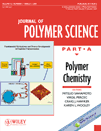Synthesis of ultra-high-molecular-weight poly(α-olefin)s by thiobis(phenoxy)titanium/modified methylaluminoxane system
Abstract
Polymerization of 1-butene with thiobis(phenoxy)titanium dichloride (TBPTiCl2) with modified methylaluminoxane (MMAO) yielded atactic and regioirregular poly(1-butene) with low molecular weight. However, productivity was increased and the yielded polymer structure was changed when water-modified MMAO (WM-MMAO) was used as a cocatalyst. The molecular weight of obtained polymer with TBPTiCl2/WM-MMAO was dramatically increased and reached over 9 million g/mol. Poly(1-butene) produced by this catalytic system was almost regioregular and slightly isotactic. 1-Hexene and 1-octene were also polymerized by this catalytic system. In all cases, the ultra-high-molecular-weight polymers were obtained. These results showed that the modified structure of the MMAO cluster by water affects the productivity, molecular weight, regioregularity, and stereoregularity of yielded polyolefins. © 2004 Wiley Periodicals, Inc. J Polym Sci Part A: Polym Chem 42: 1107–1111, 2004




